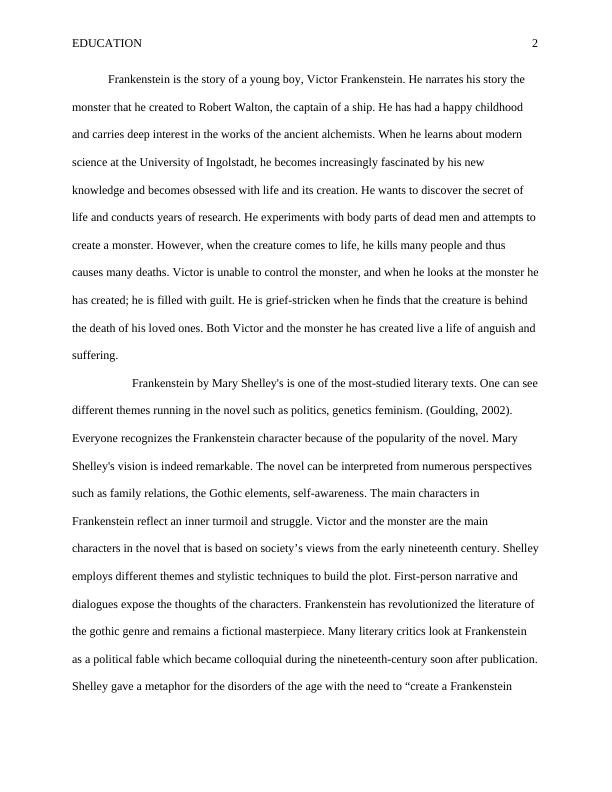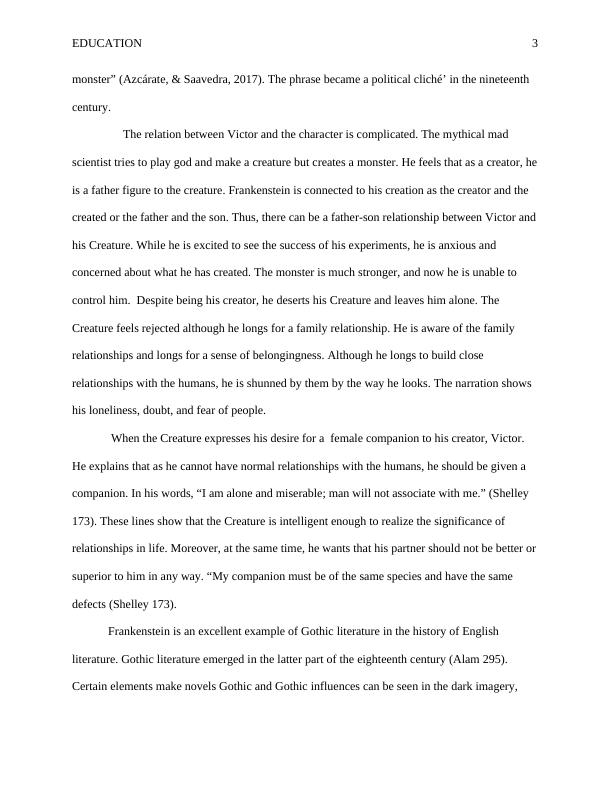Frankenstein: A Gothic Masterpiece
Added on 2023-05-28
6 Pages1677 Words467 Views
Running Head: ENGLISH 1
Frankenstein story
Author's Name
Institutional Affiliation
Introduction
Frankenstein story
Author's Name
Institutional Affiliation
Introduction

EDUCATION 2
Frankenstein is the story of a young boy, Victor Frankenstein. He narrates his story the
monster that he created to Robert Walton, the captain of a ship. He has had a happy childhood
and carries deep interest in the works of the ancient alchemists. When he learns about modern
science at the University of Ingolstadt, he becomes increasingly fascinated by his new
knowledge and becomes obsessed with life and its creation. He wants to discover the secret of
life and conducts years of research. He experiments with body parts of dead men and attempts to
create a monster. However, when the creature comes to life, he kills many people and thus
causes many deaths. Victor is unable to control the monster, and when he looks at the monster he
has created; he is filled with guilt. He is grief-stricken when he finds that the creature is behind
the death of his loved ones. Both Victor and the monster he has created live a life of anguish and
suffering.
Frankenstein by Mary Shelley's is one of the most-studied literary texts. One can see
different themes running in the novel such as politics, genetics feminism. (Goulding, 2002).
Everyone recognizes the Frankenstein character because of the popularity of the novel. Mary
Shelley's vision is indeed remarkable. The novel can be interpreted from numerous perspectives
such as family relations, the Gothic elements, self-awareness. The main characters in
Frankenstein reflect an inner turmoil and struggle. Victor and the monster are the main
characters in the novel that is based on society’s views from the early nineteenth century. Shelley
employs different themes and stylistic techniques to build the plot. First-person narrative and
dialogues expose the thoughts of the characters. Frankenstein has revolutionized the literature of
the gothic genre and remains a fictional masterpiece. Many literary critics look at Frankenstein
as a political fable which became colloquial during the nineteenth-century soon after publication.
Shelley gave a metaphor for the disorders of the age with the need to “create a Frankenstein
Frankenstein is the story of a young boy, Victor Frankenstein. He narrates his story the
monster that he created to Robert Walton, the captain of a ship. He has had a happy childhood
and carries deep interest in the works of the ancient alchemists. When he learns about modern
science at the University of Ingolstadt, he becomes increasingly fascinated by his new
knowledge and becomes obsessed with life and its creation. He wants to discover the secret of
life and conducts years of research. He experiments with body parts of dead men and attempts to
create a monster. However, when the creature comes to life, he kills many people and thus
causes many deaths. Victor is unable to control the monster, and when he looks at the monster he
has created; he is filled with guilt. He is grief-stricken when he finds that the creature is behind
the death of his loved ones. Both Victor and the monster he has created live a life of anguish and
suffering.
Frankenstein by Mary Shelley's is one of the most-studied literary texts. One can see
different themes running in the novel such as politics, genetics feminism. (Goulding, 2002).
Everyone recognizes the Frankenstein character because of the popularity of the novel. Mary
Shelley's vision is indeed remarkable. The novel can be interpreted from numerous perspectives
such as family relations, the Gothic elements, self-awareness. The main characters in
Frankenstein reflect an inner turmoil and struggle. Victor and the monster are the main
characters in the novel that is based on society’s views from the early nineteenth century. Shelley
employs different themes and stylistic techniques to build the plot. First-person narrative and
dialogues expose the thoughts of the characters. Frankenstein has revolutionized the literature of
the gothic genre and remains a fictional masterpiece. Many literary critics look at Frankenstein
as a political fable which became colloquial during the nineteenth-century soon after publication.
Shelley gave a metaphor for the disorders of the age with the need to “create a Frankenstein

EDUCATION 3
monster” (Azcárate, & Saavedra, 2017). The phrase became a political cliché’ in the nineteenth
century.
The relation between Victor and the character is complicated. The mythical mad
scientist tries to play god and make a creature but creates a monster. He feels that as a creator, he
is a father figure to the creature. Frankenstein is connected to his creation as the creator and the
created or the father and the son. Thus, there can be a father-son relationship between Victor and
his Creature. While he is excited to see the success of his experiments, he is anxious and
concerned about what he has created. The monster is much stronger, and now he is unable to
control him. Despite being his creator, he deserts his Creature and leaves him alone. The
Creature feels rejected although he longs for a family relationship. He is aware of the family
relationships and longs for a sense of belongingness. Although he longs to build close
relationships with the humans, he is shunned by them by the way he looks. The narration shows
his loneliness, doubt, and fear of people.
When the Creature expresses his desire for a female companion to his creator, Victor.
He explains that as he cannot have normal relationships with the humans, he should be given a
companion. In his words, “I am alone and miserable; man will not associate with me.” (Shelley
173). These lines show that the Creature is intelligent enough to realize the significance of
relationships in life. Moreover, at the same time, he wants that his partner should not be better or
superior to him in any way. “My companion must be of the same species and have the same
defects (Shelley 173).
Frankenstein is an excellent example of Gothic literature in the history of English
literature. Gothic literature emerged in the latter part of the eighteenth century (Alam 295).
Certain elements make novels Gothic and Gothic influences can be seen in the dark imagery,
monster” (Azcárate, & Saavedra, 2017). The phrase became a political cliché’ in the nineteenth
century.
The relation between Victor and the character is complicated. The mythical mad
scientist tries to play god and make a creature but creates a monster. He feels that as a creator, he
is a father figure to the creature. Frankenstein is connected to his creation as the creator and the
created or the father and the son. Thus, there can be a father-son relationship between Victor and
his Creature. While he is excited to see the success of his experiments, he is anxious and
concerned about what he has created. The monster is much stronger, and now he is unable to
control him. Despite being his creator, he deserts his Creature and leaves him alone. The
Creature feels rejected although he longs for a family relationship. He is aware of the family
relationships and longs for a sense of belongingness. Although he longs to build close
relationships with the humans, he is shunned by them by the way he looks. The narration shows
his loneliness, doubt, and fear of people.
When the Creature expresses his desire for a female companion to his creator, Victor.
He explains that as he cannot have normal relationships with the humans, he should be given a
companion. In his words, “I am alone and miserable; man will not associate with me.” (Shelley
173). These lines show that the Creature is intelligent enough to realize the significance of
relationships in life. Moreover, at the same time, he wants that his partner should not be better or
superior to him in any way. “My companion must be of the same species and have the same
defects (Shelley 173).
Frankenstein is an excellent example of Gothic literature in the history of English
literature. Gothic literature emerged in the latter part of the eighteenth century (Alam 295).
Certain elements make novels Gothic and Gothic influences can be seen in the dark imagery,

End of preview
Want to access all the pages? Upload your documents or become a member.
Related Documents
Frankenstein Novel | English Literaturelg...
|6
|1622
|23
The Gothic Novels - Frankensteinlg...
|7
|2101
|173
Male Gothic: Apex Predators in Dracula and Frankensteinlg...
|6
|1856
|93
Gothic Elements and Anxiety in Mary Shelley's Frankensteinlg...
|7
|2114
|319
Individualism in Mary Shelley's Frankensteinlg...
|5
|1116
|411
Assignment on Gender Roles with Regards “Frankenstein”lg...
|4
|1136
|25
